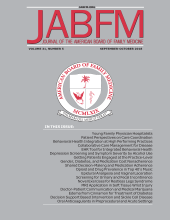Abstract
Background: We describe the implementation and subsequent use of a computerized health maintenance tracking system in a large, urban, North Carolina community health center (Lincoln Community Health Center) as part of a larger study designed to increase rates of mammography, Papanicolaou tests, and smoking cessation in low-income African-Americans.
Methods: Clinicians from the Lincoln Community Health Center were involved in the design and implementation of the computer system. At each office visit, clinicians received a computerized encounter form indicating needed screening tests, counseling, and immunizations for each randomly selected study patient (n = 1318).
Results: Initial clinician compliance rates with filling out the form were 95 percent (mammography), 82 percent (Papanicolaou test), 77 percent (clinician breast examination), and 55 percent (smoking cessation). Cumulative compliance leveled off at 21 months to 65 percent, 57 percent, 53 percent, and 38 percent, respectively, despite multiple reminder strategies. When surveyed, most clinicians thought it was a good reminder system but said they did not always complete the form because of time demands. Costs of adapting and implementing the system were $23,332.08 ($17.70 per study). Per-patient costs would have been reduced further if more patients had been included in the project.
Conclusions: State-of-the-art computer prompting systems can be useful in a community health center; however, even with prompting, clinicians still only addressed health maintenance with their patients about 50 percent of the time. Additional interventions will be needed, particularly in low-income populations, to meet the Healthy People 2000 goals in health promotion.







